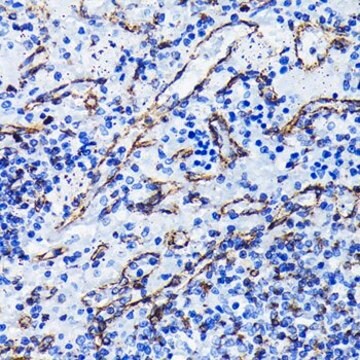MAB3400
Anti-Vimentin Antibody, clone V9
clone V9, Chemicon®, from mouse
Synonym(s):
Vimentin antibody
About This Item
Recommended Products
biological source
mouse
Quality Level
antibody form
purified antibody
antibody product type
primary antibodies
clone
V9, monoclonal
species reactivity
monkey, feline, pig, bovine, rat, human, chicken, canine
should not react with
mouse
manufacturer/tradename
Chemicon®
technique(s)
immunocytochemistry: suitable
immunohistochemistry (formalin-fixed, paraffin-embedded sections): suitable
western blot: suitable
isotype
IgG1
NCBI accession no.
UniProt accession no.
shipped in
wet ice
target post-translational modification
unmodified
Gene Information
human ... VIM(7431)
General description
Specificity
Immunogen
Application
A dilution of 1:1000 was used in a previous lot.
Immunohistochemistry:
5-10 μg/mL was used on a previous lot; can be used on formalin fixed paraffin embedded tissues with traditional high temperature, citrate buffer treatments. Prolonged formalin fixation can reduce antivbody reactivity.
Immunocytochemistry:
5-10 μg/mL of a previous lot was used in IC.
Optimal working dilutions must be determined by end user.
Quality
Western Blot:
1:1000 dilution of this antibody detected VIMENTIN on 10 μg of HeLa lysates
Target description
Linkage
Physical form
Other Notes
Legal Information
Not finding the right product?
Try our Product Selector Tool.
recommended
Storage Class Code
10 - Combustible liquids
WGK
WGK 2
Certificates of Analysis (COA)
Search for Certificates of Analysis (COA) by entering the products Lot/Batch Number. Lot and Batch Numbers can be found on a product’s label following the words ‘Lot’ or ‘Batch’.
Already Own This Product?
Find documentation for the products that you have recently purchased in the Document Library.
Protocols
How to stain organoids? A complete step-by-step protocol for immunofluorescent (IF) and immunocytochemical (ICC) staining of organoid cultures using antibodies
Our team of scientists has experience in all areas of research including Life Science, Material Science, Chemical Synthesis, Chromatography, Analytical and many others.
Contact Technical Service








